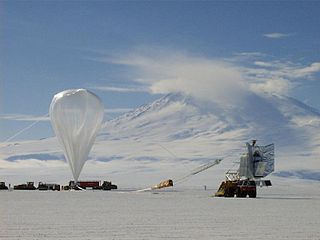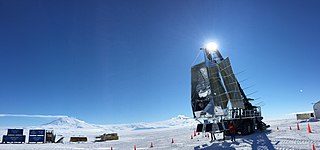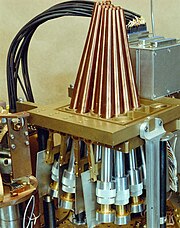
The cosmic microwave background, or relic radiation, is microwave radiation that fills all space in the observable universe. With a standard optical telescope, the background space between stars and galaxies is almost completely dark. However, a sufficiently sensitive radio telescope detects a faint background glow that is almost uniform and is not associated with any star, galaxy, or other object. This glow is strongest in the microwave region of the radio spectrum. The accidental discovery of the CMB in 1965 by American radio astronomers Arno Penzias and Robert Wilson was the culmination of work initiated in the 1940s.

The Wilkinson Microwave Anisotropy Probe (WMAP), originally known as the Microwave Anisotropy Probe, was a NASA spacecraft operating from 2001 to 2010 which measured temperature differences across the sky in the cosmic microwave background (CMB) – the radiant heat remaining from the Big Bang. Headed by Professor Charles L. Bennett of Johns Hopkins University, the mission was developed in a joint partnership between the NASA Goddard Space Flight Center and Princeton University. The WMAP spacecraft was launched on 30 June 2001 from Florida. The WMAP mission succeeded the COBE space mission and was the second medium-class (MIDEX) spacecraft in the NASA Explorer program. In 2003, MAP was renamed WMAP in honor of cosmologist David Todd Wilkinson (1935–2002), who had been a member of the mission's science team. After nine years of operations, WMAP was switched off in 2010, following the launch of the more advanced Planck spacecraft by European Space Agency (ESA) in 2009.

The Cosmic Background Explorer, also referred to as Explorer 66, was a NASA satellite dedicated to cosmology, which operated from 1989 to 1993. Its goals were to investigate the cosmic microwave background radiation of the universe and provide measurements that would help shape our understanding of the cosmos.

The Sunyaev–Zeldovich effect is the spectral distortion of the cosmic microwave background (CMB) through inverse Compton scattering by high-energy electrons in galaxy clusters, in which the low-energy CMB photons receive an average energy boost during collision with the high-energy cluster electrons. Observed distortions of the cosmic microwave background spectrum are used to detect the disturbance of density in the universe. Using the Sunyaev–Zeldovich effect, dense clusters of galaxies have been observed.

Observational cosmology is the study of the structure, the evolution and the origin of the universe through observation, using instruments such as telescopes and cosmic ray detectors.

The Cosmic Background Imager was a 13-element interferometer perched at an elevation of 5,080 metres at Llano de Chajnantor Observatory in the Chilean Andes. It started operations in 1999 to study the cosmic microwave background radiation and ran until 2008.

BOOMERanG experiment was an experiment that flew a telescope on a (high-altitude) balloon and measured the cosmic microwave background radiation of a part of the sky during three sub-orbital flights. It was the first experiment to make large, high-fidelity images of the CMB temperature anisotropies, and is best known for the discovery in 2000 that the geometry of the universe is close to flat, with similar results from the competing MAXIMA experiment.

The Very Small Array (VSA) was a 14-element interferometric radio telescope operating between 26 and 36 GHz that is used to study the cosmic microwave background radiation. It was a collaboration between the University of Cambridge, University of Manchester and the Instituto de Astrofisica de Canarias (Tenerife), and was located at the Observatorio del Teide on Tenerife. The array was built at the Mullard Radio Astronomy Observatory by the Cavendish Astrophysics Group and Jodrell Bank Observatory, and was funded by PPARC. The design was strongly based on the Cosmic Anisotropy Telescope.

The South Pole Telescope (SPT) is a 10-metre (390 in) diameter telescope located at the Amundsen–Scott South Pole Station, Antarctica. The telescope is designed for observations in the microwave, millimeter-wave, and submillimeter-wave regions of the electromagnetic spectrum, with the particular design goal of measuring the faint, diffuse emission from the cosmic microwave background (CMB). Key results include a wide and deep survey of discovering hundreds of clusters of galaxies using the Sunyaev–Zel'dovich effect, a sensitive 5 arcminute CMB power spectrum survey, and the first detection of B-mode polarized CMB.

The Atacama Cosmology Telescope (ACT) was a cosmological millimeter-wave telescope located on Cerro Toco in the Atacama Desert in the north of Chile. ACT made high-sensitivity, arcminute resolution, microwave-wavelength surveys of the sky in order to study the cosmic microwave background radiation (CMB), the relic radiation left by the Big Bang process. Located 40 km from San Pedro de Atacama, at an altitude of 5,190 metres (17,030 ft), it was one of the highest ground-based telescopes in the world.

George Fitzgerald Smoot III is an American astrophysicist, cosmologist, Nobel laureate, and the second contestant to win the $1 million prize on Are You Smarter than a 5th Grader? He won the Nobel Prize in Physics in 2006 for his work on the Cosmic Background Explorer with John C. Mather that led to the "discovery of the black body form and anisotropy of the cosmic microwave background radiation".
The Degree Angular Scale Interferometer (DASI) was a telescope installed at the U.S. National Science Foundation's Amundsen–Scott South Pole Station in Antarctica. It was a 13-element interferometer operating between 26 and 36 GHz in ten bands. The instrument is similar in design to the Cosmic Background Imager (CBI) and the Very Small Array (VSA). In 2001 The DASI team announced the most detailed measurements of the temperature, or power spectrum of the cosmic microwave background (CMB). These results contained the first detection of the 2nd and 3rd acoustic peaks in the CMB, which were important evidence for inflation theory. This announcement was done in conjunction with the BOOMERanG and MAXIMA experiment. In 2002 the team reported the first detection of polarization anisotropies in the CMB.

Spider is a balloon-borne experiment designed to search for primordial gravitational waves imprinted on the cosmic microwave background (CMB). Measuring the strength of this signal puts limits on inflationary theory.
The Saskatoon experiment was a ground-based telescope experiment to measure the anisotropy of the cosmic microwave background (CMB) at multipole moments between 60 and 360. It was named after Saskatoon, Saskatchewan, Canada, where the experiment took place, occurring in the Canadian winters of 1993 to 1995.

Archeops was a balloon-borne instrument dedicated to measuring the Cosmic microwave background (CMB) temperature anisotropies. The study of this radiation is essential to obtain precise information on the evolution of the Universe: density, Hubble constant, age of the Universe, etc. To achieve this goal, measurements were done with devices cooled down at 100mK temperature placed at the focus of a warm telescope. To avoid atmospheric disturbance the whole apparatus is placed on a gondola below a helium balloon that reaches 40 km altitude.
The E and B Experiment (EBEX) will measure the cosmic microwave background radiation of a part of the sky during two sub-orbital (high-altitude) balloon flights. It is an experiment to make large, high-fidelity images of the CMB polarization anisotropies. By using a telescope which flies at over 42,000 metres high, it is possible to reduce the atmospheric absorption of microwaves to a minimum. This allows massive cost reduction compared to a satellite probe, though only a small part of the sky can be scanned and for shorter duration than a typical satellite mission such as WMAP.

QUIET was an astronomy experiment to study the polarization of the cosmic microwave background radiation. QUIET stands for Q/U Imaging ExperimenT. The Q/U in the name refers to the ability of the telescope to measure the Q and U Stokes parameters simultaneously. QUIET was located at an elevation of 5,080 metres at Llano de Chajnantor Observatory in the Chilean Andes. It began observing in late 2008 and finished observing in December 2010.

A balloon-borne telescope is a type of airborne telescope, a sub-orbital astronomical telescope that is suspended below one or more stratospheric balloons, allowing it to be lifted above the lower, dense part of the Earth's atmosphere. This has the advantage of improving the resolution limit of the telescope at a much lower cost than for a space telescope. It also allows observation of frequency bands that are blocked by the atmosphere.

POLARBEAR is a cosmic microwave background polarization experiment located in the Atacama Desert of northern Chile in the Antofagasta Region. The POLARBEAR experiment is mounted on the Huan Tran Telescope (HTT) at the James Ax Observatory in the Chajnantor Science Reserve. The HTT is located near the Atacama Cosmology Telescope on the slopes of Cerro Toco at an altitude of nearly 5,200 m (17,100 ft).

















